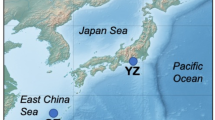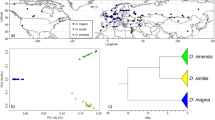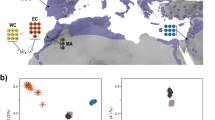Abstract
The alvinellid polychaetes, which live in the hottest part of the deep-sea hydrothermal environment, have a nested island-like distribution and locally are subjected to extinctions. They are sedentary and exhibit a peculiar reproductive behaviour and a development which may result in little or no planktonic stage (i.e. larval dispersal). The genetic variation within and among populations of the three main species (Alvinella pompejana, Alvinella caudata and Paralvinella grasslei) inhabiting vents along the East Pacific Rise was examined at a hierarchy of spatial scales using allozyme electrophoresis. The genetic diversity of P. grasslei is high (Ho = 0.24), about twice that of both the Alvinella species (Ho = 0.10). The three species show a strong tendency towards a heterozygote deficiency which systematically occurs at the same loci in nearly all the populations. These structures are particularly obvious in the genus Alvinella and might be explained by differential allozyme fitness. Populations display considerable genetic differentiation at the microgeographical scale, which could be explained by repeated founder effects in populations, but it varies from species to species according to their possible ability to be transported by crabs from vent to vent. However, the genetic variation among populations separated by at least 1000 km is of the same magnitude as that found within the 13°N/EPR segment. These results demonstrate that each species maintains its genetic identity along the oceanic rifts despite the evidence for founder effects. To explain this phenomenon, we hypothesize that in such a harsh environment, genetic drift in alvinellid populations could be balanced by a uniform selective pressure stemming from the vent chemistry.
Similar content being viewed by others
Article PDF
References
Avise, J C. 1994. Molecular Markers, Natural History and Evolution. Chapman and Hall, New York, London.
Ayala, F J, Valentine, J W, Hedgecock, D, and Barr, L G. 1975. Deep-sea asteroids: high genetic variability in a stable environment. Evolution, 29, 203–212.
Black, M B. 1991. Genetic (Allozyme) Variation in Vestimentifera (Ridgeia spp ) from Hydrothermal Vents of the Juan de Fuca Ridge (Northeast Pacific Ocean). M. Sc. Thesis, University of Victoria, Canada.
Bonhomme, F, Belkhir, K, Mathieu, E, and Roux, M. 1993. GENETIX — Logiciel d'analyse des données en génétique des populations, version 0.0. Université des Sciences et Techniques du Languedoc, Montpellier, France.
Bristow, G A, and Vadas, S R L. 1991. Genetic variability in bloodworm (Glycera dibranchiata) populations in the Gulf of Maine. Mar Biol, 109, 311–319.
Brown, A H D. 1970. The estimation of Wright's fixation index from genotypic frequencies. Genetica, 41, 399–406.
Bucklin, A. 1988. Allozymic variability of Riflia pachyptila populations from the Galapagos Rift and 21°N hydrothermal vents. Deep-Sea Res, 35, 1759–1768.
Cherry, R, Desbruyères, D, Heyraud, M, and Nolan, C. 1992. High levels of natural radioactivity in hydrothermal vent polychaetes. C r Acad Sci Paris, sér III, 315, 21–26.
Chevaldonné, P, Desbruyères, D, and Childress, J J. 1992. ... and some even hotter. Nature, 359, 593–594.
Chevaldonné, P, Desbruyères, D, and Le Haître, M. 1991. Time-series of temperature from three deep-sea hydrothermal vent sites. Deep-Sea Res, 38, 1417–1430.
Chevaldonné, P, and Jollivet, D. 1993. Videoscopic study of deep-sea hydrothermal vent alvinellid polychaete populations: biomass estimation and behaviour. Mar Ecol Prog Ser, 95, 251–262.
Denis, F, Jollivet, D, and Moraga, D. 1993. Genetic separation of two allopatric populations of hydrothermal snails Alviniconcha spp. (Gastropoda) from two Southwestern Pacific back-arc basins. Biochem Syst Ecol, 21, 431–440.
Desbruyères, D, and Laubier, L. 1980. Alvinella pompejana gen. sp. nov., aberrant Ampharetidae from the East Pacific Rise hydrothermal vents. Oceanol Acta, 3, 267–274.
Desbruyères, D, and Laubier, L. 1986. Les Alvuiellidae, une famille nouvelle d'annélides polychètes inféodées aux sources hydrothermales sous-marines: systématique, biologie et écologie. Can J Zool, 64, 2227–2245.
Dwiono, S A P, Moraga, D, Le Pennec, M, and Monnet, J. 1989. Genetic variability of the Lucinidae: Loupes lucinalis, Lucinella divaricata and Lucinoma borealis minor (Molluca: Bivalvia) from Brittany, France. Biochem Syst Ecol, 17, 463–468.
Edmond, J M, Von Damm, K L, McDuff, R E, and Measures, C I. 1982. Chemistry of hot springs on the East Pacific Rise and their effluent dispersal. Nature, 297, 187–191.
France, S C, Hessler, R R, and Vrijenhoek, R C. 1992. Genetic differentiation between spatially-disjunct populations of the deep-sea, hydrothermal vent-endemic amphipod Ventiella sulfuris. Mar Biol, 114, 551–559.
Fustec, A, Desbruyères, D, and Juniper, S K. 1987. Deep-sea hydrothermal vent communities at 13°N on the East Pacific Rise: microdistribution and temporal variations. Biol Oceanogr, 4, 121–164.
Gaill, F, Halpern, S, Quintana, C, and Desbruyères, D. 1984. Présence intracellulaire d'arsenic et de zinc associés au soufre chez une Polychète des sources hydrothermales (Alvinella pompejana). C r Acad Sci Paris, sér III, 298, 331–336.
Gooch, J L, and Schopf, J J M. 1972. Genetic variability in the deep-sea: relation to environmental variability. Evolution, 26, 545–552.
Grassle, J P. 1985. Genetic differentiation in populations of hydrothermal vent mussels (Bathymodiolus thermophilus) from the Galapagos Rift and 13°N on the East Pacific Rise. Biol Soc Wash Bull, 6, 429–442.
Grassle, J P, and Grassle, J F. 1976. Sibling species in the marine pollution indicator Capitella (Polychaeta). Science, 192, 567–569.
Harris, H, and Hopkinson, D A. 1976. Handbook of Enzyme Electrophoresis in Human Genetics. North-Holland Publishing Company, Amsterdam.
Hartl, D L. 1988. A Primer of Population Genetics, 2nd edn. Sinauer Associates, Sunderland, MA.
Haymon, R M, Fornari, D J, Von Damm, K L, Lilley, M D, Perfit, M R, Edmond, J M, Shanks, W C, Lutz, R A, Grebmeier, J M, Carbotte, S, Wright, D, McLaughlin, E, Smith, M, Beedle, N, and Olson, E. 1993. Volcanic eruption of the mid-ocean ridge along the East Pacific Rise crest at 9° 45 52′N: direct submersible observations of sea-floor phenomena associated with an eruption event in April, 1991. Earth Planet Sci Lett, 119, 85–101.
Hessler, R R, and Lonsdale, P F. 1991. Biogeography of Mariana Trough hydrothermal vent communities. Deep-Sea Res, 38, 185–199.
Hessler, R R, Smithey, W M, Boudrias, M A, Keller, C H, Lutz, R A, and Childress, J J. 1988. Temporal change in megafauna at the Rose Garden hydrothermal vent. Deep-Sea Res, 35, 1681–1710.
Hochberg, Y. 1988. A sharper Bonferroni procedure for multiple tests of significance. Biometrika, 75, 800–802.
Johnson, M S, and Black, R. 1982. Chaotic genetic patchiness in an intertidal limpet, Siphonaria spp. Mar Biol, 70, 157–164.
Johnson, M S, and Black, R. 1991. Genetic subdivision of the intertidal snail Bembicium vittatum (Gasteropoda: Littorinidae) varies with habitat in the Houtman Abrolhos Islands, Western Australia. Heredity, 67, 205–213.
Jollivet, D. 1993. Distribution et évolution de la faune associée aux sources hydrothermales profondes à 13°N sur la dorsale du Pacifique oriental: le cas particulier des polychètes Alvinellidae. Thèse de Doctorat N. R., Université de Bretagne Occidentale, France.
Karl, S A, and Avise, J C. 1992. Balancing selection at allozyme loci in oysters: implications from nuclear RFLPs. Science, 256, 100–102.
Kimura, M, and Weiss, G H. 1964. The stepping stone model of population structure and the decrease of genetic correlation with distance. Genetics, 49, 561–576.
Koehn, R K, and Bayne, B L. 1989. Towards a physiological and genetical understanding of the energetics of the stress response. Biol J Linn Soc, 37, 157–171.
Lalou, C. 1991. Deep-sea hydrothermal venting: a recently discovered marine system. J Mar Syst, 1, 403–440.
Levene, H. 1949. On a matching problem arising in genetics. Ann Math Stat, 20, 91–94.
Lonsdale, P F. 1977. Clustering of suspension-feeding macrobenthos near abyssal hydrothermal vents at oceanic spreading centers. Deep-Sea Res, 24, 857–863.
Manly, B F J. 1985. The Statistics of Natural Selection on Animal Populations. Chapman and Hall, London.
McCauley, D E. 1991. Genetic consequences of local population extinction and recolonization. Trends Ecol Evol, 6, 5–8.
McHugh, D. 1989. Population structure and reproductive biology of two sympatric hydrothermal vent polychaetes, Paralvinella pandorae and Paralvinella palmiformis. Mar Biol, 103, 95–106.
Michard, G, Albarède, F, Michard, A, Minster, J, Charlou, J L, and Tan, N. 1984. Chemistry of solutions from the 13°N East Pacific Rise hydrothermal site. Earth Planet Sci Lett, 67, 297–307.
Nei, M. 1977. F-statistics and analysis of gene diversity in subdivided populations. Ann Hum Genet, 41, 225–233.
Nevo, E, Kim, Y J, Shaw, C R, and Thaeler, C S. 1974. Genetic variation, selection, and speciation in Thomomys talpoides pocket gophers. Evolution, 28, 1–23.
Nicklas, N L, and Hoffman, R J. 1979. Genetic similarity between two morphologically similar species of polychaetes. Mar Biol, 52, 53–59.
Pasteur, N, Pasteur, G, Bonhomme, F, Catalan, J, and Britton-Davidian, J. 1987. Manuel Technique de Génétique par Électrophorèse des Protéines. Lavoisier, Paris.
Planes, S, Borsa, P, Galzin, R, and Bonhomme, F. 1994. Geographical structure and gene flow in the manini (convict surgeonfish, Acanthurus triostegus) in the south-central Pacific. In: Beaumont, A. R. (ed.) Genetics and Evolution of Aquatic Organisms, pp. 113–121. Chapman and Hall, London.
Siebenaller, J F. 1978. Genetic variation in deep-sea invertebrate populations: the bathyal gastropod Bathybembix bairdii. Mar Biol, 47, 265–275.
Slatkin, M. 1985. Rare alleles as indicators of gene flow. Evolution, 39, 53–65.
Slatkin, M, and Barton, N H. 1989. A comparison of three indirect methods for estimating average levels of gene flow. Evolution, 43, 1349–1368.
Sokal, R R, and Rohlf, F J. 1981. Biometry, 2nd edn. Freeman and Co., San Francisco.
Soulé, M. 1976. Allozyme variation: its determinant in space and time. In: Ayala, F. J. (ed.) Molecular Evolution, pp. 60–76. Sinauer Associates, Sunderland, MA.
Swofford, D L, and Selander, R B. 1989. BIOSYS-1. A computer program for the analysis of allelic variation in population genetics and biochemical systematics. Release 1.7. University of Illinois, Urbana, IL.
Tunnicliffe, V. 1988. Biogeography and evolution of hydrothermal-vent fauna in the eastern Pacific Ocean. Proc R Soc B, 233, 347–366.
Tunnicliffe, V. 1991. The biology of hydrothermal vents: Ecology and evolution. Oceanogr Mar Biol Ann Rev, 29, 319–407.
Tunnicliffe, V, Desbruyères, D, Jollivet, D, and Laubier, L. 1993. Systematic and ecological characteristics of Paralvinella sulfïncola Desbruyères and Laubier, a new polychaete (family Alvinellidae) from northeast Pacific hydrothermal vents. Can J Zool, 71, 286–297.
Tunnicliffe, V, and Jensen, R G. 1987. Distribution and behavior of the spider crab Macroregonia macrochira Sakai (Brachyura) around the hydrothermal vents of the northeast Pacific. Can J Zool, 65, 2443–2449.
Vithayasai, C. 1973. Exact critical values of the Hardy-Weinberg test statistic for two alleles. Commun Stat, 1, 229–242.
Vrijenhoek, R C, Lutz, R A, Craddock, C, Black, M B, Karl, S, Hoeh, W R, and Gustafson, R. 1993. Gene flow and speciation in deep-sea hydrothermal vent organisms. In: Catzeflis, F. M. (ed.) Evolution, 93, p. 484. Fourth Congress of the European Society for Evolutionary Biology, Montpellier, France.
Watremez, P, and Kervevan, C. 1990. Origine des variations de l'activité hydrothermale: premiers éléments de réponse d'un modèle numérique simple. C r Acad Sci Paris, sér II, 153–158.
Watts, R J, Johnson, M S, and Black, R. 1990. Effects of recruitment on genetic patchiness in the urchin Echinometra mathaei in Western Australia. Mar Biol, 105, 145–151.
Weir, B S. 1990. Intraspecific differentiation. In: Hillis, D. M. and Moritz, C. (eds) Molecular Systematics, pp. 373–410. Sinauer Associates, Sunderland, MA.
Weir, B S, and Cockerham, C C. 1984. Estimating F-statistics for the analysis of population structure. Evolution, 38, 1358–1370.
Workman, P L, and Niswander, J D. 1970. Population studies on southwestern Indian tribes. II. Local genetic differentiation in the Papago. Am J Hum Genet, 22, 24–49.
Wright, S. 1965. The interpretation of population structure by F-statistics with special regard to systems of mating. Evolution, 19, 395–420.
Zal, F, Desbruyères, D, and Louin-Toulmond, C. 1994. Sexual dimorphism in Paralvinella grasslei, a polychaete annelid from deep-sea hydrothermal vents. C r Acad Sci Paris, Life sciences, 317, 42–48.
Zouros, E, and Foltz, D W. 1984. Possible explanations of heterozygote deficiency in bivalve molluscs. Malacologia, 25, 583–591.
Author information
Authors and Affiliations
Rights and permissions
About this article
Cite this article
Jollivet, D., Desbruyères, D., Bonhomme, F. et al. Genetic differentiation of deep-sea hydrothermal vent alvinellid populations (Annelida: Polychaeta) along the East Pacific Rise. Heredity 74, 376–391 (1995). https://doi.org/10.1038/hdy.1995.56
Received:
Issue date:
DOI: https://doi.org/10.1038/hdy.1995.56
Keywords
This article is cited by
-
Molecular taxonomy confirms morphological classification of deep-sea hydrothermal vent copepods (Dirivultidae) and suggests broad physiological tolerance of species and frequent dispersal along ridges
Marine Biology (2011)
-
Determining gene flow and the influence of selection across the equatorial barrier of the East Pacific Rise in the tube-dwelling polychaete Alvinella pompejana
BMC Evolutionary Biology (2010)
-
Geographic clines and stepping-stone patterns detected along the East Pacific Rise in the vetigastropod Lepetodrilus elevatus reflect species crypticism
Marine Biology (2008)
-
Genetic comparison of two populations of the deep-sea vent shrimp Rimicaris exoculata (Decapoda: Bresiliidae) from the Mid-Atlantic Ridge
Marine Biology (1996)
-
Specific and genetic diversity at deep-sea hydrothermal vents: an overview
Biodiversity and Conservation (1996)



